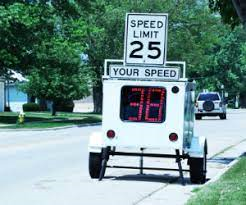Speed Management
Ensuring a data driven, objective, and balanced analytical approach, GRPC strives to provide information for the development of projects and programs that increase safety, improve mobility, and access to opportunity, while promoting quality of life.

SAFETY & SECURITY
Objective:
Reduce motor vehicle crash fatalities and serious injuries
Strategy:
Address aggressive driving by implementing speed management strategies such as traffic calming, road design changes, conducting education and outreach, setting appropriate speed limits, and strategically using speed safety cameras to address speed along key corridors.
Performance Measure:
Number of serious injury and fatality crashes

Travel Speed
Speeding is among the most significant contributing factors to fatal collisions. The severity of collisions increases dramatically with the speed of collision. Reducing speeds is the best, easiest, and fastest way to quickly radically improve safety, for both drivers and pedestrians and bicyclists. Drivers have a wider field of vision and are more likely to notice other road-users at lower speeds. It is crucial not only to the motorist’s ability to avoid crashes but also to the survival of non-motorists in a crash.
Simply dropping speed limits or even enforcement isn’t the answer. Most people don’t drive according to the speed limit, they drive according to the “feel” of the road. Street design is the most powerful governor of driver behavior such as lane and shoulder widths and sight distance and obstructions.
Impacts from high speeds
- High car speeds can reduce walking and biking due to unsafe conditions leading to negative heath impacts.
- Children’s independent mobility is particularly susceptible to the risks associated with high traffic speeds because of the fear of traffic danger.
- Local social interactions are disrupted by high-speed traffic due to perceived unfriendliness of street environments, leading to a loss of social connectedness.
- High-speed traffic encourages urban sprawl.
- The faster the speed of traffic, the higher the level of air pollution and noise pollution.

One response to “Speed Management”
In Pass Christian there is only one section of median along Rte #90 that is 18 INCHES wide ( other areas being wide, grassy, with oaks in the median) . Not only is this NOT ADA compliant, but also encourages drivers to speed up along this “runway”. I have paced cars along the route, from Cedar & Rt#90 east to almost Magnolia & Rt#90, in both directions, and the majority go 65 mph and faster in a 45mph zone. I have spoken with MDOT in Jackson, who agree it is a bad place, but nothing can be done because of easements. Nothing is impossible. I believe space can be carved out of the south side easement (look at how the parking “pullouts” have been created). I think only an additional 24″ might be enough, Please help cut down on the speeders any way possible, and reduce the danger of speeders.. Even the beach sidewalks are not safe from a car losing control and taking out a baby in a stroller.